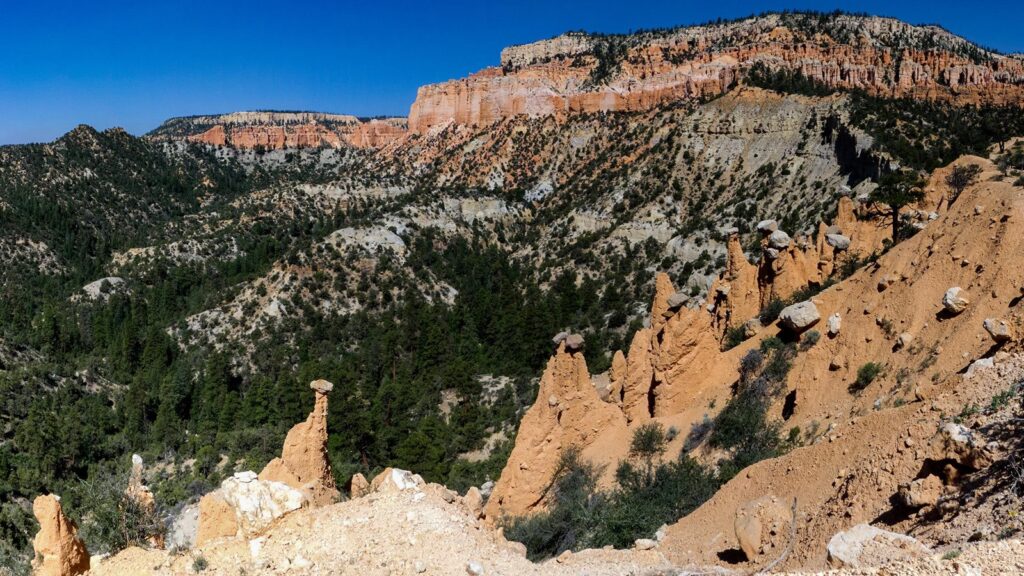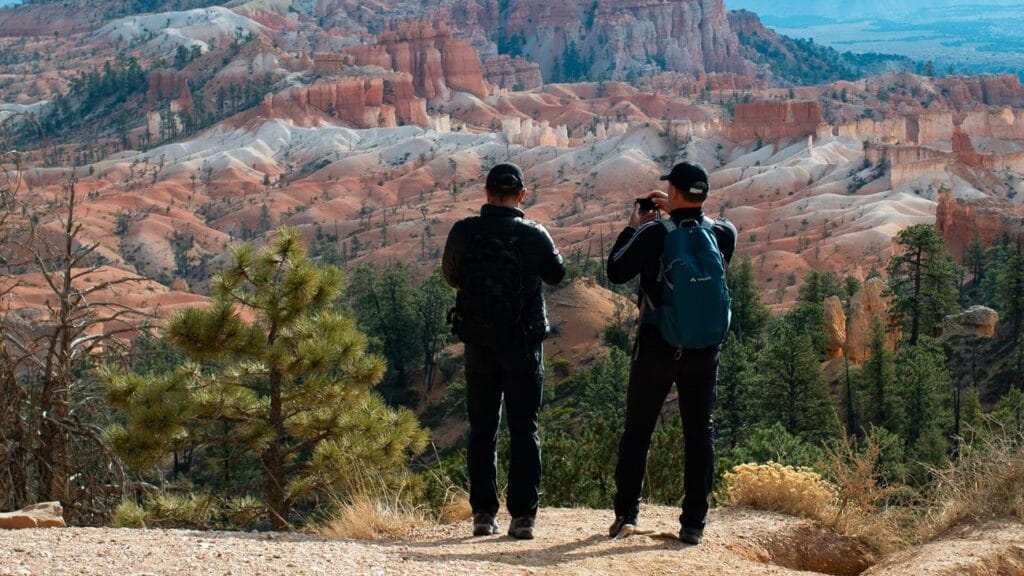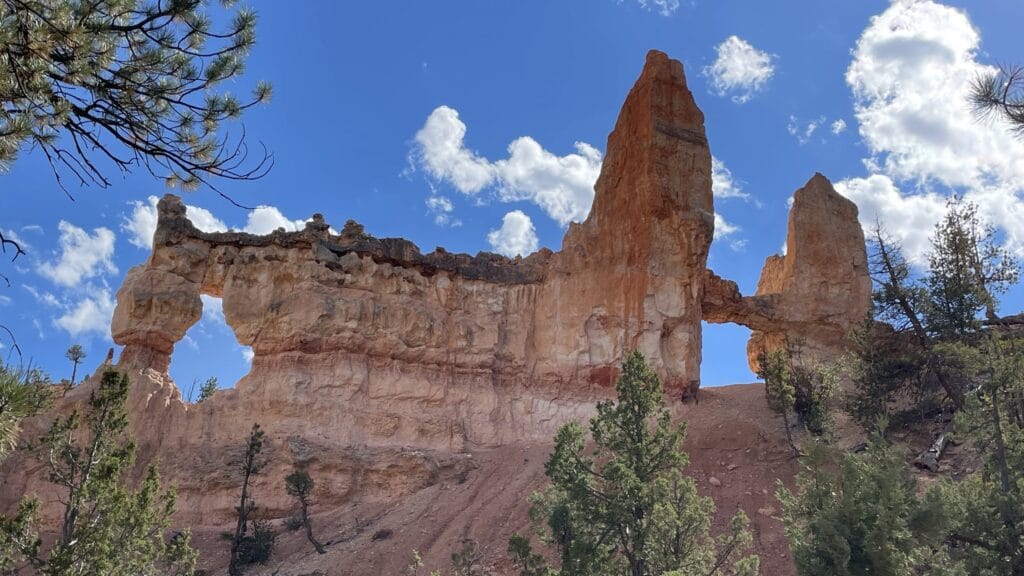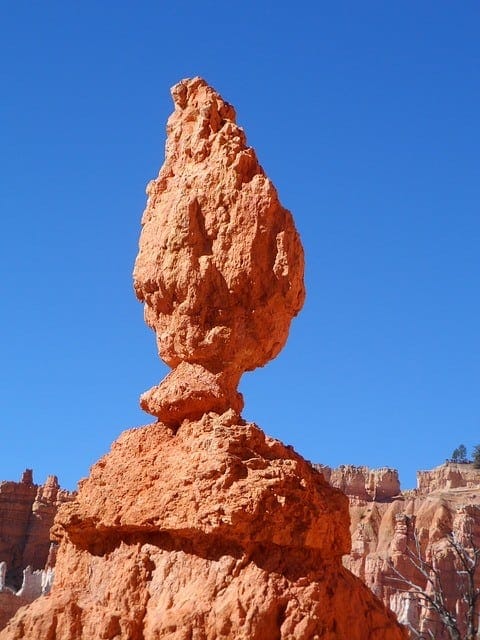Bryce Canyon National Park is one of the most breathtaking hiking destinations in the United States. Known for its surreal red rock formations, towering hoodoos, and endless views of natural amphitheaters, the park feels like a world sculpted by time and wind. Whether you’re a seasoned hiker chasing your next challenge or a beginner looking for a scenic stroll, Bryce Canyon National Park has a trail for you. From easy rim walks to steep descents into the canyons, each hike reveals a new perspective of this stunning landscape.
In this guide, we’ll explore the park’s top trails, the best times of year to visit, hidden gems you won’t want to miss, safety and weather considerations, and what you need to know about camping and permits before you go.
The Best Hiking Trails in Bryce Canyon National Park

- Distance: 1.3 miles round trip
- Difficulty: Moderate
- Terrain: Steep switchbacks, loose gravel, narrow paths
The Navajo Loop Trail is one of the most iconic hikes in Bryce Canyon National Park. It begins at Sunset Point and descends quickly into the canyon through towering walls of orange and red rock. You’ll pass famous landmarks like Wall Street, where the cliffs rise dramatically on both sides, and Thor’s Hammer, a hoodoo that perfectly balances a massive boulder on a narrow column. The climb back up is steep but rewarding, offering sweeping views of the amphitheater as you ascend.
Tip: This trail connects with the Queen’s Garden Trail for a longer, more scenic loop that gives you a fuller experience of the canyon.
2. Queen’s Garden Trail
- Distance: 1.8 miles round trip (3 miles if combined with Navajo Loop)
- Difficulty: Easy to Moderate
- Terrain: Sandy paths, moderate elevation changes
The Queen’s Garden Trail is one of the most popular and accessible routes for beginners. It starts at Sunrise Point and winds gently down into the amphitheater, offering up-close views of hoodoos and arches. The trail is named after a rock formation that resembles Queen Victoria, which you’ll spot near the end.
Because it’s not as steep as other trails, it’s perfect for families or anyone looking for a less strenuous adventure in Bryce Canyon National Park. Early morning hikes provide cooler temperatures and fewer crowds.

3. Peekaboo Loop Trail
- Distance: 5.5 miles round trip
- Difficulty: Strenuous
- Terrain: Steep climbs, rolling hills, and uneven surfaces
For those seeking a more challenging hike, the Peekaboo Loop Trail offers incredible rewards. Starting near Bryce Point, this loop takes you deep into the heart of the canyon, where you’ll walk among hoodoos and arches that seem to defy gravity. It’s one of the best ways to fully immerse yourself in the park’s geology and color palette.
Because of its difficulty and exposure to the sun, it’s best to hike Peekaboo Loop early in the day, especially during summer. Bring plenty of water, sunscreen, and a hat.

4. Fairyland Loop Trail
- Distance: 8 miles round trip
- Difficulty: Moderate to Strenuous
- Terrain: Long inclines, dirt trails, scenic overlooks
If you want a quieter experience away from the crowds, the Fairyland Loop Trail is a hidden treasure. It begins at Fairyland Point and meanders through unique rock formations with fewer visitors than other major trails. You’ll see panoramic views of the amphitheater and pass landmarks like Tower Bridge and China Wall.
The trail can take four to five hours, so plan accordingly and pack snacks. This hike is often cited by locals as one of the most underrated experiences in Bryce Canyon National Park.

5. Rim Trail
- Distance: 11 miles (one way)
- Difficulty: Easy to Moderate
- Terrain: Paved and dirt sections along the rim, minimal elevation change
For hikers who prefer breathtaking views without descending into the canyon, the Rim Trail is ideal. It runs between Fairyland Point and Bryce Point, offering continuous overlooks into the amphitheater below. You can choose to hike shorter sections, like the route between Sunrise and Sunset Points, which is just half a mile.
Because the Rim Trail connects to most major viewpoints, it’s a great way to experience the variety of landscapes within Bryce Canyon National Park at your own pace.

Weather and Best Times to Visit
The weather in Bryce Canyon National Park changes dramatically with each season, shaping the experience for hikers and sightseers alike. Because the park sits at a high elevation of over 8,000 feet, temperatures can swing from warm afternoons to chilly mornings within a single day. Understanding what to expect in each season will help you plan your trip and make the most of your time on the trails.
Spring (March to May)
Spring marks the beginning of hiking season in Bryce Canyon National Park. As the snow melts, trails begin to reopen, revealing the red and orange rock formations dusted with the last traces of winter. Daytime temperatures typically range from 40°F to 65°F, creating comfortable conditions for hiking and photography.
Wildflowers begin to bloom across the meadows, adding vibrant splashes of color to the landscape. Because the higher elevations can remain icy into early April, it’s important to check trail conditions before setting out. This season also tends to be less crowded than summer, making it an excellent time for peaceful exploration and stunning sunrise photography.
Summer (June to August)
Summer is the most popular time to visit Bryce Canyon National Park, and for good reason. The weather is generally pleasant, with average highs in the upper 70s and cool evenings that drop into the 50s. Thanks to the park’s elevation, even on the warmest days, the air feels crisp and manageable for hikers.
However, summer also brings afternoon thunderstorms, especially in July and August. Lightning can be dangerous in exposed areas, so it’s best to start your hikes early in the morning and be off the trails by early afternoon. Crowds are at their peak this time of year, so booking accommodations and campsites in advance is essential. Despite the busier atmosphere, this season offers the longest daylight hours, giving you plenty of time to explore the park’s many viewpoints and trails.
Fall (September to November)
Fall is often considered the best time to visit Bryce Canyon National Park. The weather cools down, ranging from 45°F to 70°F, and the summer crowds begin to thin. The crisp air, golden aspen trees, and deep blue skies create a breathtaking backdrop for hiking and photography.
Many visitors find that the lower temperatures make longer hikes, such as the Fairyland Loop or Peekaboo Trail, more enjoyable. Wildlife sightings also become more common, with mule deer and foxes often spotted in the early morning or late evening. Fall’s balanced weather and moderate crowd levels make it ideal for those who want the full park experience without the summer rush.
Winter (December to February)
Winter transforms Bryce Canyon National Park into a snowy wonderland. The red hoodoos contrast beautifully against the white snow, creating some of the most striking scenery you’ll ever see. Temperatures can dip below freezing, often ranging from 20°F to 40°F during the day, so proper winter gear is essential.
While some of the lower trails may close due to snow and ice, the rim viewpoints remain open and offer incredible photo opportunities. The park is also much quieter in winter, providing a sense of solitude that’s hard to find during other times of the year. Visitors can enjoy activities like snowshoeing and cross-country skiing along designated routes.

Hidden Gems in Bryce Canyon National Park
Beyond the famous viewpoints, Bryce Canyon National Park is full of lesser-known spots that reward curious travelers.
- Mossy Cave Trail: Located outside the main amphitheater, this short 0.8-mile trail leads to a small waterfall and a mossy grotto. It’s family-friendly and often less crowded than the main park trails.
- Inspiration Point: While technically well-known, it’s often less visited early in the morning. The layered hoodoos glow beautifully at sunrise, offering one of the best photo opportunities in the park.
- Tower Bridge: Found along the Fairyland Loop Trail, this natural rock arch resembles the famous landmark in London and makes a great midway stop for photos.
- Bristlecone Loop: Near Rainbow Point, this short 1-mile trail showcases ancient bristlecone pine trees, some of which are over 1,500 years old.
These hidden gems add depth to your visit and show that Bryce Canyon National Park has much more to offer beyond its main viewpoints.
Camping and Permits
Camping in Bryce Canyon National Park lets you experience the serenity of the park after sunset, when the crowds leave and the night sky fills with stars.
There are two main campgrounds:
- North Campground: Located near the visitor center and open year-round. Sites are first-come, first-served outside the summer reservation window.
- Sunset Campground: Open seasonally from late spring through early fall. Reservations are available on Recreation.gov.
If you plan to backpack into the park’s backcountry, you’ll need a backcountry camping permit, which can be obtained from the visitor center. Permits are limited to preserve the natural environment and should be arranged in advance.
Both campgrounds have restrooms, fire rings, and picnic tables, but showers and full hookups are not available. Fires are allowed only in designated fire grates, and collecting firewood within the park is prohibited.
For those who prefer comfort, nearby towns like Bryce Canyon City and Tropic offer cabins, lodges, and hotels within a short drive of the park entrance.
Safety Tips for Hikers
Hiking in Bryce Canyon National Park can be safe and enjoyable as long as you take a few precautions.
- Stay on marked trails. The park’s terrain is steep, and venturing off-path can lead to dangerous drops or unstable ground.
- Bring plenty of water. The dry climate and high elevation can dehydrate you faster than expected. Carry at least one liter per hour of hiking.
- Wear proper footwear. Trails can be dusty, slippery, or uneven. Hiking boots with good grip are essential.
- Be mindful of altitude. At over 8,000 feet, you may feel fatigued faster. Rest often and pace yourself.
- Start early. Afternoon thunderstorms and high UV exposure are common in summer. Morning hikes offer cooler temperatures and fewer crowds.
- Respect wildlife. You may see mule deer, prairie dogs, or ravens, but never feed or approach them.
- Carry a map or download offline navigation. Some areas have limited cell service.
The park’s rangers regularly patrol popular trails and are available for guidance or assistance. It’s also smart to let someone know your plans if you’re venturing onto longer routes.
Why Bryce Canyon National Park Belongs on Your List
There’s a reason travelers describe Bryce Canyon National Park as one of the most magical places on Earth. The glowing hoodoos, the crisp mountain air, and the endless views of red and orange cliffs create a setting unlike anywhere else. Whether you’re walking a gentle rim path or tackling the steep switchbacks of the Peekaboo Loop, every step feels like an adventure through time.
From the star-filled nights at the campgrounds to the sunrise views from Inspiration Point, Bryce Canyon National Park offers something for every type of hiker. Its combination of accessibility, natural beauty, and diversity of trails make it a must-visit destination for anyone who loves the outdoors.
So pack your boots, grab your camera, and prepare to be amazed. Once you experience the wonder of Bryce Canyon National Park, you’ll understand why it deserves a top spot on every hiker’s bucket list.
